NVIDIA Announces GeForce RTX 30 Series for Laptops: Mobile Ampere Available Jan. 26th
by Ryan Smith on January 12, 2021 3:00 PM EST
As the cornerstone of their CES 2021 keynote, NVIDIA today has announced their GeForce RTX 30 series graphics adapters for laptops. Based on the same Ampere architecture and the same GPUs as NVIDIA’s existing desktop GeForce cards, the RTX 30 series for laptops will bring Ampere’s features and much of its performance to laptops, just tuned to the sub-150 Watt power requirements that come with a laptop. Laptops will be getting versions of the RTX 3080, RTX 3070, and RTX 3060, with the first of these new generation of laptops set to become available later this month, on January 26th.
Though an obligatory step in the roll-out of a new GPU architecture, the release of laptop parts is an important one for NVIDIA and its OEM partners. Laptops represent an ever-growing share of the PC gaming market, and perhaps just as importantly for NVIDIA, it’s a market that, above entry-level discrete graphics, they have virtually complete control of. So a big part of NVIDIA’s fortunes hinge in part on getting laptop gamers to upgrade to new machines with the latest and greatest in NVIDIA graphics technology. In fact in some respects laptops are more important than desktops, as the low power needs for laptops means that these machines get some of the best chips NVIDIA bins – which in turn tends to be reflected in the prices of some of these laptops.
For their latest generation, while not being explicitly noted by NVIDIA, it looks like a change in nomenclature is at hand. In the past couple of generations the company has simply referred to their mobile parts with the same name as their desktop parts – e.g. GeForce RTX 2080. However for the RTX 30 series, we’re seeing parts listed as “laptop GPU”, e.g. “GeForce RTX 3080 Laptop GPU”. It’s a small change, but an important one: as we look at the specifications, it’s clear that NVIDIA isn’t always using the same GPU in a mobile part as they have its desktop counterpart, so any kind of true equivalency between laptop and desktop has gone out the window. In practice, laptop graphics adapters have always been their own product family, and now by returning to having distinct naming and specifications for their laptop adapters, NVIDIA has gone back to more clearly defining this structure.
| NVIDIA GeForce RTX 30 Series Laptop Specifications | |||||
| RTX 3080 Laptop GPU |
RTX 3070 Laptop GPU |
RTX 3060 Laptop GPU |
|||
| CUDA Cores | 6144 | 5120 | 3840 | ||
| ROPs | 96? | 80? | 64? | ||
| Boost Clock | 1245 - 1710MHz | 1290 - 1620MHz | 1283 - 1703MHz | ||
| Memory Clock | ?Gbps GDDR6 | ?Gbps GDDR6 | ?Gbps GDDR6 | ||
| Memory Bus Width | 256-bit | 256-bit | 192-bit | ||
| VRAM | 8GB / 16GB | 8GB | 6GB | ||
| TDP Range | 80 - 150W+ | 80 - 125W | 60 - 115W | ||
| GPU | GA104 | GA104 | GA106 | ||
| Architecture | Ampere | Ampere | Ampere | ||
| Manufacturing Process | Samsung 8nm | Samsung 8nm | Samsung 8nm? | ||
| Launch Date | 01/26/2021 | 01/26/2021 | 01/26/2021 | ||
GeForce RTX 3080 Laptop GPU
Diving into specifications and features, the new GeForce RTX 30 series adapters cover the RTX 3080, RTX 3070, and RTX 3060 families. And though NVIDIA’s own specifications don’t explicitly list what GPUs are driving these configurations, based on the number of CUDA cores and other factors, it looks like NVIDIA is using a mix of the existing GA104 GPU and what would be their new GA106 GPU to drive these parts. Notably, RTX 3080 in the desktop uses a cut-down GA102 part, not GA104, and with GA102 being unsuitable for anything short of a quite literal desktop replacement notebook, GA104 instead sits at the heart of the RTX 3080 Laptop GPU as well as all flavors of RTX 3070.
The leading member of their new laptop adapters, the RTX 3080 Laptop GPU – or what I'm calling 3080L for short – appears to be based on a fully-enabled GA104 GPU. All 48 SMs are enabled, as are all 8 memory channels, so 3080L stands to be GA104 in its top form. Clockspeeds for mobile parts are highly variable owing to differences in laptop cooling and TDP headroom, but officially NVIDIA is giving the boost clock for the 3080L a pretty wide berth, with a range of 1245Mhz to 1710MHz.
Meanwhile, for memory NVIDIA is using tried and true (and lower power) GDDR6. Unfortunately memory clocks are not disclosed – so it’s not immediately clear if this is going to be 12Gbps or 14Gbps memory – but for the 3080L the adapter will come with 8GB or 16GB of memory on a 256-bit bus. The inclusion of a 16GB option is a welcome change after years of 8GB being the largest laptop configuration, and it’s interesting to note that due to laptop space requirements, this strongly implies that NVIDIA is using 16Gb memory modules, which just recently hit the market, rather than their usual 8Gb modules (which need to be in a clamshell configuration to allow for 16GB of VRAM).
Finally, while power consumption/TDP is largely up to the OEMs, NVIDIA’s official guidance is that the 3080L is designed for 80W to 150W+ operation. Towards the lower-end will be Max-Q laptops and other thin and light designs, getting some of NVIDIA’s finest silicon. At the other end of the spectrum will be true DTR laptops, which can handle the 150W or more of power consumption from a graphics adapter with near-desktop performance.
GeForce RTX 3070 Laptop GPU
Following the RTX 3080 Laptop GPU is the RTX 3070 Laptop GPU (3070L). This appears to be a cut-down version of the GA104 GPU, with fewer SMs enabled and a narrower TDP range. Overall, 40 SMs are enabled here, with boost clocks ranging from 1290MHz to 1620MHz. Meanwhile memory is available in just an 8GB GDDR6 configuration, with the complete 256-bit memory bus enabled.
With an 80W to 125W TDP window, the biggest change here is likely to be felt at the high-end, where relative to the 3080L, the 3070L has both lower peak clockspeeds and fewer SMs. NVIDIA doesn’t offer a lot of performance guidance here – clearly the new laptop parts are going to be a good deal faster than the old ones, based on what we’ve seen in the desktop – but it’s worth noting that NVIDIA is pitching the 3070L as being well-suited for 1440p gaming. Which is the first time we’ve seen them seriously float the idea of 1440p with anything less than an 80-class laptop graphics adapter.
GeForce RTX 3060 Laptop GPU
Last but not least in the new mobile family is the GeForce RTX 3060 Laptop GPU (3060L). Like the desktop GeForce RTX 3060 also announced today, the specifications for the RTX 3060L point to it being based on a new GPU, which in NVIDIA’s usual naming schemes would be GA106. At this point we don’t have any detailed information about GA106 in particular, so we only know how it’s configured for the desktop and laptop 3060s respectively.
In any case, the 3060L comes with 30 SMs enabled, for a total of 3840 FP32 CUDA cores. With the usual disclaimer about TDPs applying here as well, the adapter’s boost clock is rated for anywhere between 1283MHz and 1703MHz. This would put overall performance, in terms of FP32 FLOPS, between 9.9 TFLOPS and 13.1 TFLOPS.
The memory subsystem on the 3060L has been cut down relative to the other laptop parts. Here there’s just a 192-bit memory bus, meaning that memory can only be installed in multiples of 6GB. In this case, NVIDIA has opted for 6GB for 3060L whereas desktop 3060 gets 12GB. 6GB shouldn’t be too much of a deal-breaker here, but it will stand out a bit when NVIDIA is doing more on the desktop. Otherwise, as we don’t have specific information on memory clockspeeds, it’s not clear right now if 3060L comes with 12Gbps or 14Gbps GDDR6 – though as the lowest-power SKU, the former is increasingly likely.
Speaking of power, NVIDIA’s official TDP guidance for 3060L is 60W to 115W. This puts the floor below both the 3070L and 3080L, and interestingly, also 5W below that of the RTX 2060 it replaces, which had a floor of 65W. Meanwhile 115W will be more likely to show up in DTR-like designs, which will be better able to reach the higher-end of the part’s rated boost clock.
Third Gen Max-Q Technologies
Alongside the hardware itself, NVIDIA also briefly alluded to what they’re calling their third generation of Max-Q technologies that go alongside their new Ampere-based laptop parts. Calling all of these technologies AI-powered, NVIDIA is probably paying a little fast and loose with “AI”, but at the end of the day these should be useful features for laptops. It’s also worth noting that even with the Max-Q designation, it’s likely that some of the new functionality available here will also show up in non Max-Q laptops.
Kicking things off is Dynamic Boost 2.0, the latest iteration of NVIDIA’s Dynamic Boost technology that was first introduced last April. As we wrote back at the time:
NVIDIA’s Dynamic Boost is designed to take advantage of the fact that in many laptop designs, the GPU and the CPU share a common thermal budget, typically because they are both cooled via the same set of heatpipes. In practice, this is usually done in order to allow OEMs to build relatively thin and light systems, where the cooling capacity of the system is more than the TDP either of the CPU or GPU alone, but less than the total TDP of those two processors together. This allows OEMs to design around different average, peak, and sustained workloads, offering plenty of headroom for peak performance while sacrificing some sustained performance in the name of lighter laptops.
Dynamic Boost 2.0, in turn, is the latest version of NVIDIA’s dynamic power allocation technology. This new iteration has been expanded to include not only the CPU and the GPU, but the GPU VRAM as well – indicating that NVIDIA is taking full advantage of Ampere giving its memory controller its own power rail, rather than sharing it with the GPU. Memory power consumption continues to be a hot topic, as while VRAM power consumption on the whole pales to GPU power consumption, the gap narrows in laptop designs. Unless it’s asleep, GDDR6 can be quite power hungry, especially at higher clockspeeds.
We’re still waiting on a briefing or technical paper from NVIDIA for additional details on Dynamic Boost 2.0, and in particular any additional information on the gains from including GPU memory in their dynamic power allocation budgets. Clearly it is expected to have some kind of an impact, but from the outside it’s not clear what that impact might be.
Like Dynamic Boost 1.0, 2.0 adjusts power allocations on a per-frame basis. Meanwhile, it’s worth noting that unlike Dynamic Boost 1.0, Dynamic Boost 2.0 is a mandatory feature for Max-Q laptops. So all RTX 30 series Max-Q laptops have the feature, and ship with it enabled out of the box.
NVIDIA is also rolling an updated version of their Whispermode performance/noise optimization technology. As a refresher, Whispermode is designed to throttle down a game’s performance and image quality to more optimally balance a game’s performance with the amount of noise being generated from cooling a laptop – in essence allowing the user to control whether they want full performance, or will accept some tradeoffs for a quieter system. Whispermode is particularly effective for high framerate games, since these games can be dialed down while still maintaining reasonable performance.
According to NVIDIA, Whispermode 2.0 has been reengineered from the ground up so that it’s now being designed into laptops on a system design level. NVIDIA’s published details are very thin here, but it is worth noting that NVIDIA specifically mentions Whispermode 2.0 controlling the system fans as well, something that wasn’t a feature of 1.0. Otherwise, NVIDIA is mostly reiterating the user-controllable nature of the feature, with users being able to select their “desired acoustic level”.
Wrapping up the Max-Q 3.0 technology family, NVIDIA is now putting their existing DLSS technology under this umbrella. Similarly, support for a PCIe resizable BAR, which is coming to laptops and desktops, is also being lumped in with Max-Q. In fairness, RTX 30 series laptops are getting the technology first (desktops are a couple of months behind), and although helpful, it’s by no means a Max-Q exclusive technology.
GeForce RTX 30 Series For Laptops; Biggest Laptop Launch Ever
Outside of Max-Q specific features, the GeForce RTX 30 series for laptops will also bring to laptops for the first time the rest of the new technologies that were introduced with the Ampere architecture last year. Particularly notable here is HDMI 2.1 support, giving suitable RTX 30 series laptops the ability to drive 120Hz 4K TVs, and even 8K TVs. These new GPUs also come with AV1 decoding support, which although we’re still in the very early days of AV1 support, will in time come in handy, especially on laptops using Intel Comet Lake (10th gen Core) CPUs, as the iGPU there doesn’t support AV1 decoding.
And, of course, all of these parts come with Ampere’s general architecture optimizations. The doubled FP32 CUDA core count, the doubled RT hardware, and so on will filter down into the RTX 30 series laptop parts. Overall, NVIDIA is touting a 2x efficiency improvement for their Ampere laptop parts versus the last-generation Turing parts, which is notably better than what we saw with the desktop parts, which tended to deemphasize efficiency in the name of higher total performance. But of course with laptops having very hard (and relatively low) TDP ceilings, NVIDIA and its OEM partners need to dial in their GPU clockspeeds in a more conservative and power-friendly manner.
Coincidentally, NVIDIA isn’t proving a whole lot of guidance about expected performance – at least, not relative to prior generation parts. At iso-power, 2x efficiency means 2x performance, but as TDPs are closer to design guidelines than hard limits, iso-power is a big assumption. In which case, we’re left with NVIDIA’s sole published performance chart, comparing the 3080L to its 2080 and 1080 laptop counterparts. Here it’s around 50% faster than the 2080, and opens up further against the 1080.
Broadly speaking, NVIDIA operates on an N + 2 cycle for GPU upgrades – which is to say that they assume, plan for, and promote their latest-generation hardware as being a suitable upgrade for hardware that is two generations old. So with the RTX 30 series for laptops, NVIDIA’s primary focus is going to be on getting GTX 10 series laptop owners to upgrade, hitting on both the performance differences as well as all the feature differences such as ray tracing and DLSS that were introduced in successive hardware generations.
Meanwhile NVIDIA’s product stack layout as whole is not changing much for this generation. In the back-half of the last generation, laptops with NVIDIA’s mainstream-enthusiast GPU, RTX 2060, started at $999. For the RTX 30 series, the story is much the same, with RTX 3060L laptops starting at $999. Meanwhile RTX 3070L laptops will start at $1299, and RTX 3080L laptops at $1999.
Overall, NVIDIA and its OEM partners appear to be very optimistic about the market opportunities for RTX 30 series laptops. If you haven’t already noticed the flood of laptop announcements on AnandTech today, according to NVIDIA over RTX 30 series laptops are being introduced in this launch period, with NVIDIA calling it their bigger laptop launch ever. With suitable CPUs available from both Intel and AMD this cycle, NVIDIA’s partners have more choices than ever for configuring laptops, and a market that in the last 9 months has proven to be very hungry for laptop hardware as we all remained cooped up inside.
The first RTX 30 series laptops will go on sale later this month, with retail availability expected on January 26th.


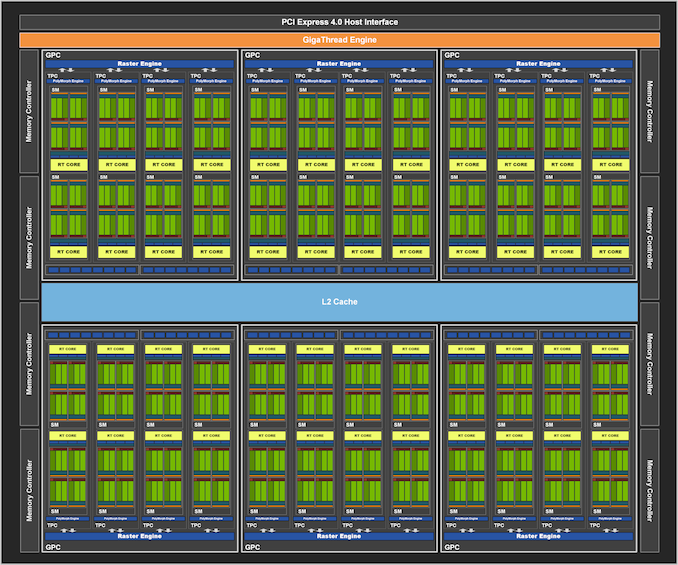
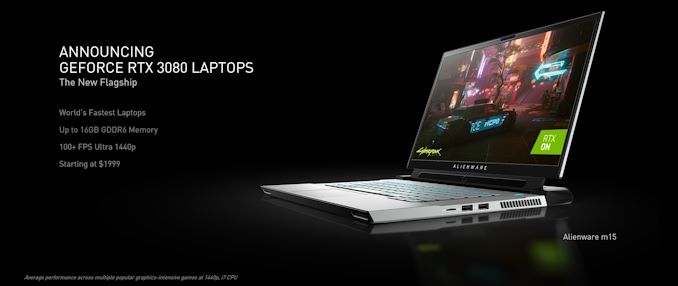
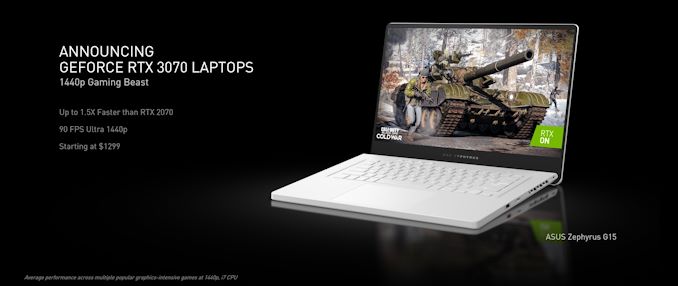
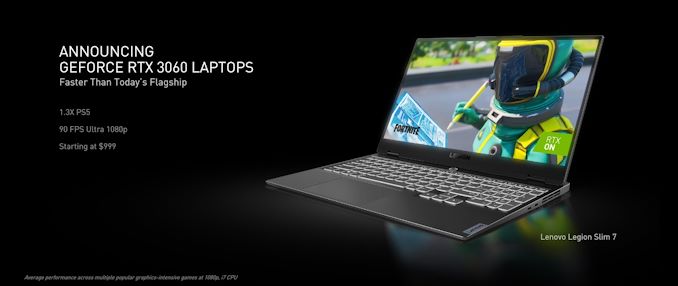

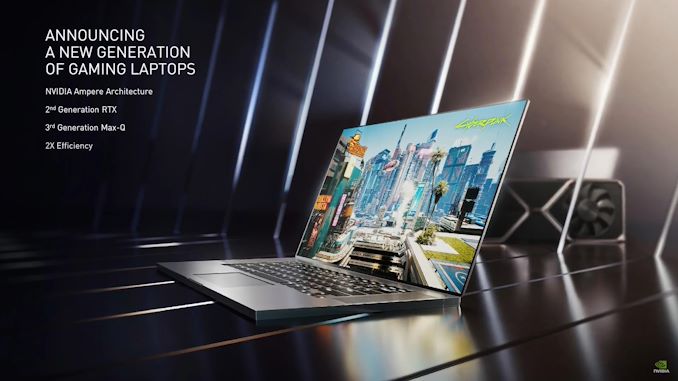
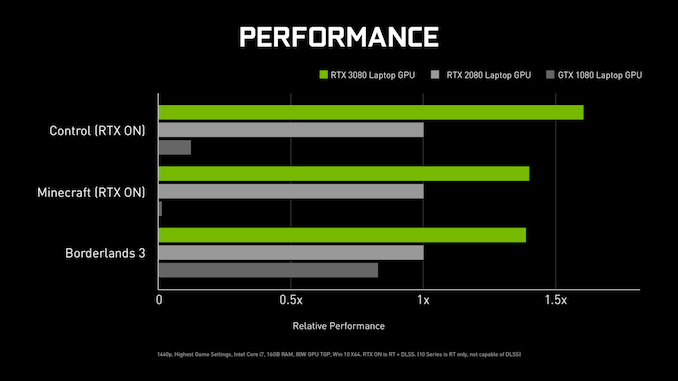









22 Comments
View All Comments
romrunning - Tuesday, January 12, 2021 - link
"The first RTX 30 series laptops will go on sale later this month, with retail availability expected on January 26th."Make sure you get in line now to get one of those two laptops! ;)
Yojimbo - Tuesday, January 12, 2021 - link
Simply not true...Spunjji - Wednesday, January 13, 2021 - link
To be fair - if they've been binning these ever since Ampere launched, they might actually have a few built up to sell.yeeeeman - Tuesday, January 12, 2021 - link
such a shame they didn't bake these on tsmc 7nm. the improvements over turing are quite small.Yojimbo - Tuesday, January 12, 2021 - link
The improvements over Turing seem healthy to me, but yeah it's a shame it's not on TSMC 7 nm from a technical perspective. From an availability and price perspective, as bad as it might seem now, I think it'd be a lot worse if it were on TSMC 7 nm.RSAUser - Wednesday, January 13, 2021 - link
The improvements are near non-existent.niva - Wednesday, January 13, 2021 - link
We will know for sure once independent reviewers get their hands on them, but you need to learn to read simple charts.Spunjji - Wednesday, January 13, 2021 - link
Gotta agree there. ~40% performance improvement (?) isn't half bad, and TSMC 7nm is rammed.lmcd - Tuesday, January 12, 2021 - link
I want a 3070 with that power consumption! Seriously, I have no idea how an ITX version of any of these cards is gonna happen.brucethemoose - Tuesday, January 12, 2021 - link
I bet dotage will stuff mobile 3070 into a little box, if they haven't already.